HR/BVP SENSOR
Model: SA9308M
- BVP is a finger-worn blood volume pulse sensor (or PPG sensor).
- It provides the BVP waveform, for heart rate, BVP amplitude, and Heart rate variability.
Product Overview
The HR/BVP sensor is a blood volume pulse (BVP) detection sensor (also known as a photoplethysmography – PPG – sensor) housed in a small finger worn package, to measure heart rate (HR) and provide BVP amplitude, BVP waveform, HR and heart rate variability (HRV) feedback.
Sensor Placement
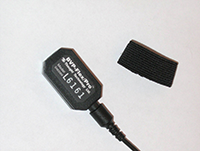 Place the sensor against the fleshy part of the first joint of any finger. The middle finger is recommended for better compatibility with the other sensors when they are all placed on the same hand.
Place the sensor against the fleshy part of the first joint of any finger. The middle finger is recommended for better compatibility with the other sensors when they are all placed on the same hand.
Note: Place the sensor label up, so that the electronic sensor components (the two small square openings) on the back of the sensor (not shown) are against the finger.
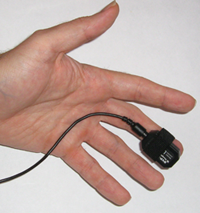 |
| With Elastic Straps |
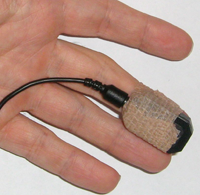 |
| With Coban tape |
Using multiple sensors together:
This configuration is suggested for placing skin conductance, BVP and temperature sensors on the same hand. In this configuration, the temperature sensor is tucked under the ring finger strap of the skin conductance sensor.
This is a practical way to combine these sensors, but care must be taken to ensure that the end of the temperature sensor is secured firmly against the skin.
Also note that the cables are all directed inwards and Coban tape is used to secure the cables to the wrist.
Technical Specifications
- Size : 20mm x 34mm x 10mm (0.72” x 1.33” x 0.41”)
- Weight : 20g (0.66 oz)
- Input range : Unit less quantity displayed as 0% – 100%
- Accuracy : ±5%
Interfacing with 3rd Party Data Acquisition Systems
Recommended Connectivity for Electrical Safety
Thought Technology recommends the use of TT Sensor Isolator ST9405AM when interfacing patient connected sensor(s) to line powered equipment(s) or devices.
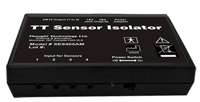 The TT Sensor Isolator ST9405AM is an interface device providing medical grade electrical isolation between the patient connected sensors and the acquisition system. It provides the equivalent of Two Means of Patient Protection under IEC 60601-1, and supplies battery power to the sensors. Using this device ensures Thought Technology sensors are safely interfaced to the analog inputs of line-powered systems such as computers with DAQ cards.
The TT Sensor Isolator ST9405AM is an interface device providing medical grade electrical isolation between the patient connected sensors and the acquisition system. It provides the equivalent of Two Means of Patient Protection under IEC 60601-1, and supplies battery power to the sensors. Using this device ensures Thought Technology sensors are safely interfaced to the analog inputs of line-powered systems such as computers with DAQ cards.
Note that this device isolates only between sensors and the DAQ interface, not between different sensor channels.
The TT Sensor Isolator can interface up to 4 sensors to a DAQ card. TT Sensor Isolator can be connected to the DAQ card in two ways:
- via two stereo jacks, or
- via a DB-15 connector; a BNC interface cable (SA9409BNC) or a pigtail cable (SA9409PGT) can be provided with the unit.

For more detailed information on the Sensor Isolator 4∞, consult the Thought Technology Science Division website or contact the sales department or your distributor.
Division website or contact the sales department or your distributor.
Direct Connectivity for Electrically Isolated Systems
The following notes are provided for qualified users to directly interface Thought Technology sensors with external systems.
WARNING: If the sensor is interfaced to non-Thought Technology devices without the use of a TT Sensor Isolator SE9405AM, an elevated risk of electrical shock may be present. In particular, if a patient-connected sensor is connected to any line powered device(s) or equipment(s), it will be the responsibility of the qualified user to ensure the electrical safety in the setup and to ensure that the device or equipment provides sufficient isolation.
To interface with a sensor, a single sensor cable may be cut in half. Both sides can then be used to make custom interfacing cables by stripping the outer insulation of each required conductor. The sensor cable contains 4 color coded conductors. The table below shows the color coding and pin connector assignment.
| Pin | Color Code | Function | Note |
| 1 | metal (shield) | ground | Signal and power ground, connection required. |
| 2 | yellow | auxiliary (sensor ID) | No connection required. |
| 3 | green | signal | Sensor output signal |
| 4 | red | sensor power | Supply voltage, +7.26V referenced to ground. Note: sensor performance may be sensitive to supply voltage. |

Notes:
1. The nominal supply voltage for this sensor is 7.26V. The sensor can safely be used with a supply voltage of up to 9V. However, as the sensor is calibrated with a 7.26V supply voltage level, changes in gain and offset may be expected when operating at a different supply voltage level, changes in gain and offset may be expected when operating at a different supply voltage.
Recommended Specifications for DAQ Hardware
- Recommended resolution of 0.15mV (16-bit ADC over 10V span) or better
- Minimum input range:
- If connected via SE9405AM Sensor Isolator, choose 0-5V (unipolar) or ±5V (bipolar).
- If directly connected to DAQ, choose ±5V (bipolar).
Simplified Transfer Function
![]() Conversion of voltage [V] to BVP%
(for quantitative purposes only)
Conversion of voltage [V] to BVP%
(for quantitative purposes only)
The simplified transfer function assumes the sensor is used with the Sensor Isolator, or the supply voltage provided in the user setup is 7.26V nominal.
Product Overview
The HR/BVP sensor is a blood volume pulse (BVP) detection sensor (also known as a photoplethysmography – PPG – sensor) housed in a small finger worn package, to measure heart rate (HR) and provide BVP amplitude, BVP waveform, HR and heart rate variability (HRV) feedback.
Sensor Placement
 Place the sensor against the fleshy part of the first joint of any finger. The middle finger is recommended for better compatibility with the other sensors when they are all placed on the same hand.
Place the sensor against the fleshy part of the first joint of any finger. The middle finger is recommended for better compatibility with the other sensors when they are all placed on the same hand.
Note: Place the sensor label up, so that the electronic sensor components (the two small square openings) on the back of the sensor (not shown) are against the finger.
 |
| With Elastic Straps |
 |
| With Coban tape |
Using multiple sensors together:
This configuration is suggested for placing skin conductance, BVP and temperature sensors on the same hand. In this configuration, the temperature sensor is tucked under the ring finger strap of the skin conductance sensor.
This is a practical way to combine these sensors, but care must be taken to ensure that the end of the temperature sensor is secured firmly against the skin.
Also note that the cables are all directed inwards and Coban tape is used to secure the cables to the wrist.
Technical Specifications
- Size : 20mm x 34mm x 10mm (0.72” x 1.33” x 0.41”)
- Weight : 20g (0.66 oz)
- Input range : Unit less quantity displayed as 0% – 100%
- Accuracy : ±5%
Interfacing with 3rd Party Data Acquisition Systems
Recommended Connectivity for Electrical Safety
Thought Technology recommends the use of TT Sensor Isolator ST9405AM when interfacing patient connected sensor(s) to line powered equipment(s) or devices.
 The TT Sensor Isolator ST9405AM is an interface device providing medical grade electrical isolation between the patient connected sensors and the acquisition system. It provides the equivalent of Two Means of Patient Protection under IEC 60601-1, and supplies battery power to the sensors. Using this device ensures Thought Technology sensors are safely interfaced to the analog inputs of line-powered systems such as computers with DAQ cards.
The TT Sensor Isolator ST9405AM is an interface device providing medical grade electrical isolation between the patient connected sensors and the acquisition system. It provides the equivalent of Two Means of Patient Protection under IEC 60601-1, and supplies battery power to the sensors. Using this device ensures Thought Technology sensors are safely interfaced to the analog inputs of line-powered systems such as computers with DAQ cards.
Note that this device isolates only between sensors and the DAQ interface, not between different sensor channels.
The TT Sensor Isolator can interface up to 4 sensors to a DAQ card. TT Sensor Isolator can be connected to the DAQ card in two ways:
- via two stereo jacks, or
- via a DB-15 connector; a BNC interface cable (SA9409BNC) or a pigtail cable (SA9409PGT) can be provided with the unit.

For more detailed information on the Sensor Isolator 4∞, consult the Thought Technology Science Division website or contact the sales department or your distributor.
Division website or contact the sales department or your distributor.
Direct Connectivity for Electrically Isolated Systems
The following notes are provided for qualified users to directly interface Thought Technology sensors with external systems.
WARNING: If the sensor is interfaced to non-Thought Technology devices without the use of a TT Sensor Isolator SE9405AM, an elevated risk of electrical shock may be present. In particular, if a patient-connected sensor is connected to any line powered device(s) or equipment(s), it will be the responsibility of the qualified user to ensure the electrical safety in the setup and to ensure that the device or equipment provides sufficient isolation.
To interface with a sensor, a single sensor cable may be cut in half. Both sides can then be used to make custom interfacing cables by stripping the outer insulation of each required conductor. The sensor cable contains 4 color coded conductors. The table below shows the color coding and pin connector assignment.
| Pin | Color Code | Function | Note |
| 1 | metal (shield) | ground | Signal and power ground, connection required. |
| 2 | yellow | auxiliary (sensor ID) | No connection required. |
| 3 | green | signal | Sensor output signal |
| 4 | red | sensor power | Supply voltage, +7.26V referenced to ground. Note: sensor performance may be sensitive to supply voltage. |

Notes:
1. The nominal supply voltage for this sensor is 7.26V. The sensor can safely be used with a supply voltage of up to 9V. However, as the sensor is calibrated with a 7.26V supply voltage level, changes in gain and offset may be expected when operating at a different supply voltage level, changes in gain and offset may be expected when operating at a different supply voltage.
Recommended Specifications for DAQ Hardware
- Recommended resolution of 0.15mV (16-bit ADC over 10V span) or better
- Minimum input range:
- If connected via SE9405AM Sensor Isolator, choose 0-5V (unipolar) or ±5V (bipolar).
- If directly connected to DAQ, choose ±5V (bipolar).
Simplified Transfer Function
![]() Conversion of voltage [V] to BVP%
(for quantitative purposes only)
Conversion of voltage [V] to BVP%
(for quantitative purposes only)
The simplified transfer function assumes the sensor is used with the Sensor Isolator, or the supply voltage provided in the user setup is 7.26V nominal.
Technical Specifications
| Size : 20mm x 34mm x 10mm (0.72” x 1.33” x 0.41”) |
| Weight :20g (0.66 oz) |
| Input range :Unit less quantity displayed as 0% – 100% |
| Accuracy :±5% |
More Products to Consider
Table of Contents
Suggested References
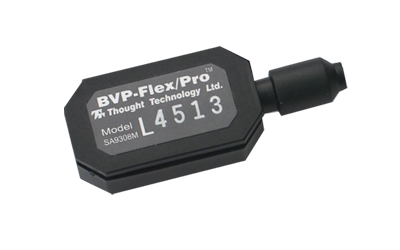
 TT Infra Sensor
TT Infra Sensor